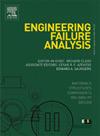Modelling of high frequency vibration of railway bogies’ subcomponent based on structural dynamics: A case study for lifeguard of metro bogie
IF 4.4
2区 工程技术
Q1 ENGINEERING, MECHANICAL
引用次数: 0
Abstract
The sub-components of railway bogie have been frequently reported to be subjected to the vibration fatigue due to the wheel/rail high frequency vibration. An efficiency numerical model is thus desirable to simulate the high frequency vibration of railway bogie, which can substantially enhance the design efficiency of railway bogie system considering the vibration fatigue. Therefore, this paper aims to proposing a modelling methodology for simulating the high frequency vibration of railway bogies’ subcomponents, and a lifeguard of metro bogie was taken as an example. Firstly, a field test measurement of lifeguard for the metro bogie was primarily introduced to demonstrate the high frequency vibration characteristics and the related failure mechanisms arising from the wheel/rail high frequency impact. Subsequently, a random vibration model for the railway bogie system and the lifeguard based on the rigid/flexible coupled dynamics were developed to simulate the high frequency vibration and the dynamic stress developed at the lifeguard. This method was subsequently employed in the structural optimization for the lifeguard. The results showed that the proposed methodology can effectively simulate the high frequency vibration of lifeguard of bogie system based on the measured axle box acceleration, and the optimized structure can effectively increase the service lifetime under the excitation of wheel/rail high frequency vibration.
基于结构动力学的铁路转向架分部件高频振动建模:地铁转向架救生舱案例研究
据报道,由于车轮/轨道的高频振动,铁路转向架的子部件经常会出现振动疲劳。因此,需要一个高效的数值模型来模拟铁路转向架的高频振动,从而大幅提高考虑振动疲劳的铁路转向架系统的设计效率。因此,本文旨在提出一种模拟铁路转向架子部件高频振动的建模方法,并以地铁转向架的救生舱为例。首先,主要介绍了地铁转向架救生舱的现场测试测量,以展示轮轨高频撞击产生的高频振动特性和相关失效机理。随后,基于刚/柔耦合动力学建立了铁路转向架系统和救生舱的随机振动模型,以模拟救生舱的高频振动和动态应力。这种方法随后被用于救生舱的结构优化。结果表明,所提出的方法可以根据测量到的轴箱加速度有效模拟转向架系统救生舱的高频振动,优化后的结构可以有效提高轮轨高频振动激励下的使用寿命。
本文章由计算机程序翻译,如有差异,请以英文原文为准。
求助全文
约1分钟内获得全文
求助全文
来源期刊

Engineering Failure Analysis
工程技术-材料科学:表征与测试
CiteScore
7.70
自引率
20.00%
发文量
956
审稿时长
47 days
期刊介绍:
Engineering Failure Analysis publishes research papers describing the analysis of engineering failures and related studies.
Papers relating to the structure, properties and behaviour of engineering materials are encouraged, particularly those which also involve the detailed application of materials parameters to problems in engineering structures, components and design. In addition to the area of materials engineering, the interacting fields of mechanical, manufacturing, aeronautical, civil, chemical, corrosion and design engineering are considered relevant. Activity should be directed at analysing engineering failures and carrying out research to help reduce the incidences of failures and to extend the operating horizons of engineering materials.
Emphasis is placed on the mechanical properties of materials and their behaviour when influenced by structure, process and environment. Metallic, polymeric, ceramic and natural materials are all included and the application of these materials to real engineering situations should be emphasised. The use of a case-study based approach is also encouraged.
Engineering Failure Analysis provides essential reference material and critical feedback into the design process thereby contributing to the prevention of engineering failures in the future. All submissions will be subject to peer review from leading experts in the field.
 求助内容:
求助内容: 应助结果提醒方式:
应助结果提醒方式:


